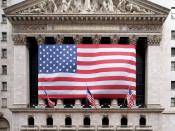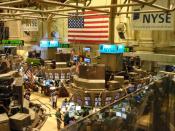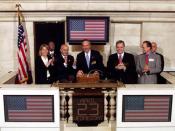The New York Stock Exchange (NYSE) is the most technologically advanced equities market in the world. It is an order driven market run by a single market maker called a specialist. The market is created by participant such as listed companies, individual investors, and member firms. Buyers and Sellers meet on the floor of the exchange, open, fair, and orderly, to get the best price based on supply and demand. There is a single limit order book where public limit orders are stored until they can be executed or are canceled by the submitter. The limit order book is maintained by the specialist. NYSE specialists have a number of affirmative obligations but are not required to maintain a continuous market where price movements should occur smoothly rather than in large jumps. Additionally, NYSE specialists are required to be supply liquidity when no one else wishes to. Both of these features may serve as "shock absorbers" when public supplied liquidity is thin.
On an average day, 1.46 billion shares are traded on the NYSE which are valued at $46.1 billion. The NYSE was the most competitive market in 2004 for trading its listed stocks which provides investors with the lowest costs, deepest liquidity, and best prices.
In contrast to the NYSE, NASDAQ is largely a quote driven market without any priority rules. It is also the largest U.S. electronic stock market. NASDAQ lists more companies and, on average, trades more shares per day than any other U.S. market with approximately 3,300 companies. It is home to category-defining companies that are leaders across all areas of business including technology, retail, communications, financial services, transportation, media and biotechnology. NASDAQ is the primary market for trading NASDAQ-listed stocks. Approximately 54% of NASDAQ-listed shares traded are reported to NASDAQ systems. Competing market makers, or dealers,


